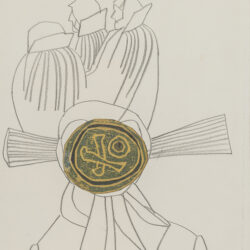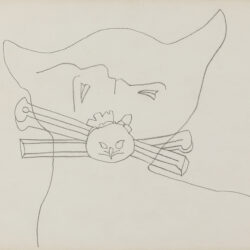“I felt the impermanent, temporary nature of everything. Finally, in 1953, all of this widened into such a deep crisis, a state of total hopelessness, when all possibilities of continuation became absent, I was flailing like a fish out of water. (…) The solution came to me in 1954, during the time spent in Sárospatak, when I borrowed a book depicting Swabian, Saxon and other German folk costumes (Hans Retzlaff: Deutsche Bauerntrachten, Berlin, 1934) from Vera Bródy. I began to draw forms and figurations from it, and then I felt that something had started there. I consciously used the »simultaneous-transparent« method developed by Lajos Vajda.” – stated Endre Bálint. Vintage Galéria’s current exhibition presents these works created mainly during Bálint’s artist residencies in Sárospatak and Zsennye between 1954 and 1957.
“This method, transparency, is a graphical representation of phenomena, where behind the transparent object another foreign object appears simultaneously, and the composition creates an intellectual-emotional tension that awakens the desire of the viewer to resolve the drama unfolding in the picture.” – wrote József Román in his monography on Bálint, published in 1980, referencing the thoughts of a philosopher fried, Lajos Szabó. He continued: “And Vajda’s transparency is a great counterpart to the human mind, since thoughts, emotions and the images of the memory often appear in consciousness covering and then revealing each other; this graphic translucency is the visual equivalent of mental association.”
Bálint based these works on found objects and illustrations, such as the name plate of János Kiss featuring a horse head, or the gate from Szentendre, which later became recurring motifs in his art. He merged these motifs, partly of folk origin, into drawn compositions, similarly to the assembling of montages, forming the method used in his later works by combining Vajda’s technique and his own sensibility. In addition to the application of the montage technique – significant both in Hungarian art at that time, and in Bálint’s later artistic practice – these drawings also brought together motifs that played an important role in the following paintings and monotypes.

